Partnering with Consumers Standard: Improving Quality and Safety
VerifiedAdded on 2023/06/13
|12
|3152
|437
Essay
AI Summary
This essay provides a detailed analysis of the Partnering with Consumers Standard within the Australian National Safety and Quality Health Service (NSQHS) framework. It explores how this standard aims to create a consumer-centered health system by actively involving patients in the design, development, and evaluation of healthcare services. The essay discusses the importance of clinical governance and quality improvement systems in supporting partnerships with consumers, including risk management, training requirements, and the implementation of relevant policies and procedures. It also identifies potential gaps in quality and safety systems, particularly concerning mental health patients, cognitive impairment, end-of-life care, low health literacy, and Aboriginal and Torres Strait Islander individuals. The essay further examines the use of data-driven approaches, such as interviews and qualitative data analysis, to gather feedback and improve healthcare practices, emphasizing the significance of data validity, meaning, and physician engagement in the process. The ultimate goal is to enhance patient outcomes, reduce healthcare costs, and ensure that healthcare services are tailored to meet the diverse needs of the Australian population.
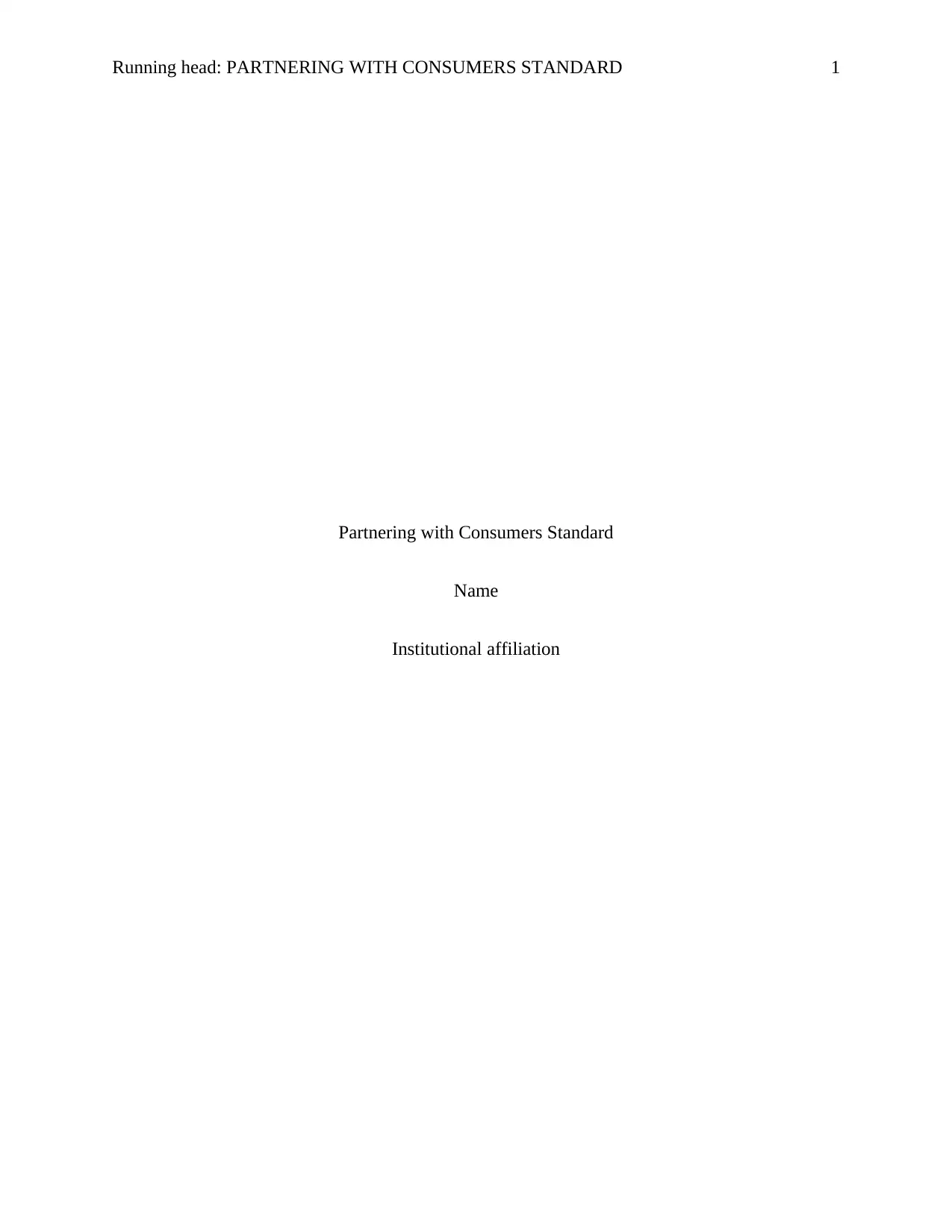
Running head: PARTNERING WITH CONSUMERS STANDARD 1
Partnering with Consumers Standard
Name
Institutional affiliation
Partnering with Consumers Standard
Name
Institutional affiliation
Paraphrase This Document
Need a fresh take? Get an instant paraphrase of this document with our AI Paraphraser
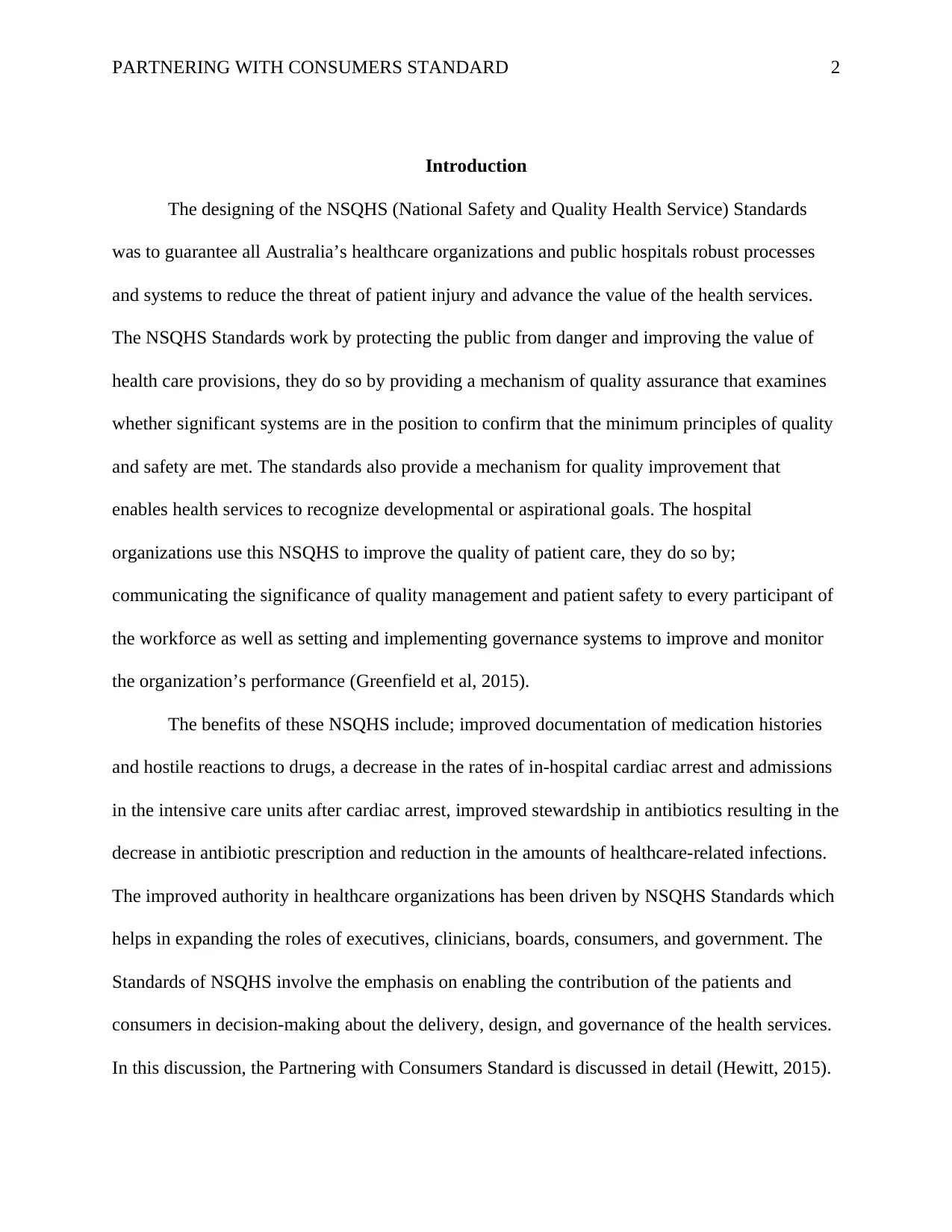
PARTNERING WITH CONSUMERS STANDARD 2
Introduction
The designing of the NSQHS (National Safety and Quality Health Service) Standards
was to guarantee all Australia’s healthcare organizations and public hospitals robust processes
and systems to reduce the threat of patient injury and advance the value of the health services.
The NSQHS Standards work by protecting the public from danger and improving the value of
health care provisions, they do so by providing a mechanism of quality assurance that examines
whether significant systems are in the position to confirm that the minimum principles of quality
and safety are met. The standards also provide a mechanism for quality improvement that
enables health services to recognize developmental or aspirational goals. The hospital
organizations use this NSQHS to improve the quality of patient care, they do so by;
communicating the significance of quality management and patient safety to every participant of
the workforce as well as setting and implementing governance systems to improve and monitor
the organization’s performance (Greenfield et al, 2015).
The benefits of these NSQHS include; improved documentation of medication histories
and hostile reactions to drugs, a decrease in the rates of in-hospital cardiac arrest and admissions
in the intensive care units after cardiac arrest, improved stewardship in antibiotics resulting in the
decrease in antibiotic prescription and reduction in the amounts of healthcare-related infections.
The improved authority in healthcare organizations has been driven by NSQHS Standards which
helps in expanding the roles of executives, clinicians, boards, consumers, and government. The
Standards of NSQHS involve the emphasis on enabling the contribution of the patients and
consumers in decision-making about the delivery, design, and governance of the health services.
In this discussion, the Partnering with Consumers Standard is discussed in detail (Hewitt, 2015).
Introduction
The designing of the NSQHS (National Safety and Quality Health Service) Standards
was to guarantee all Australia’s healthcare organizations and public hospitals robust processes
and systems to reduce the threat of patient injury and advance the value of the health services.
The NSQHS Standards work by protecting the public from danger and improving the value of
health care provisions, they do so by providing a mechanism of quality assurance that examines
whether significant systems are in the position to confirm that the minimum principles of quality
and safety are met. The standards also provide a mechanism for quality improvement that
enables health services to recognize developmental or aspirational goals. The hospital
organizations use this NSQHS to improve the quality of patient care, they do so by;
communicating the significance of quality management and patient safety to every participant of
the workforce as well as setting and implementing governance systems to improve and monitor
the organization’s performance (Greenfield et al, 2015).
The benefits of these NSQHS include; improved documentation of medication histories
and hostile reactions to drugs, a decrease in the rates of in-hospital cardiac arrest and admissions
in the intensive care units after cardiac arrest, improved stewardship in antibiotics resulting in the
decrease in antibiotic prescription and reduction in the amounts of healthcare-related infections.
The improved authority in healthcare organizations has been driven by NSQHS Standards which
helps in expanding the roles of executives, clinicians, boards, consumers, and government. The
Standards of NSQHS involve the emphasis on enabling the contribution of the patients and
consumers in decision-making about the delivery, design, and governance of the health services.
In this discussion, the Partnering with Consumers Standard is discussed in detail (Hewitt, 2015).
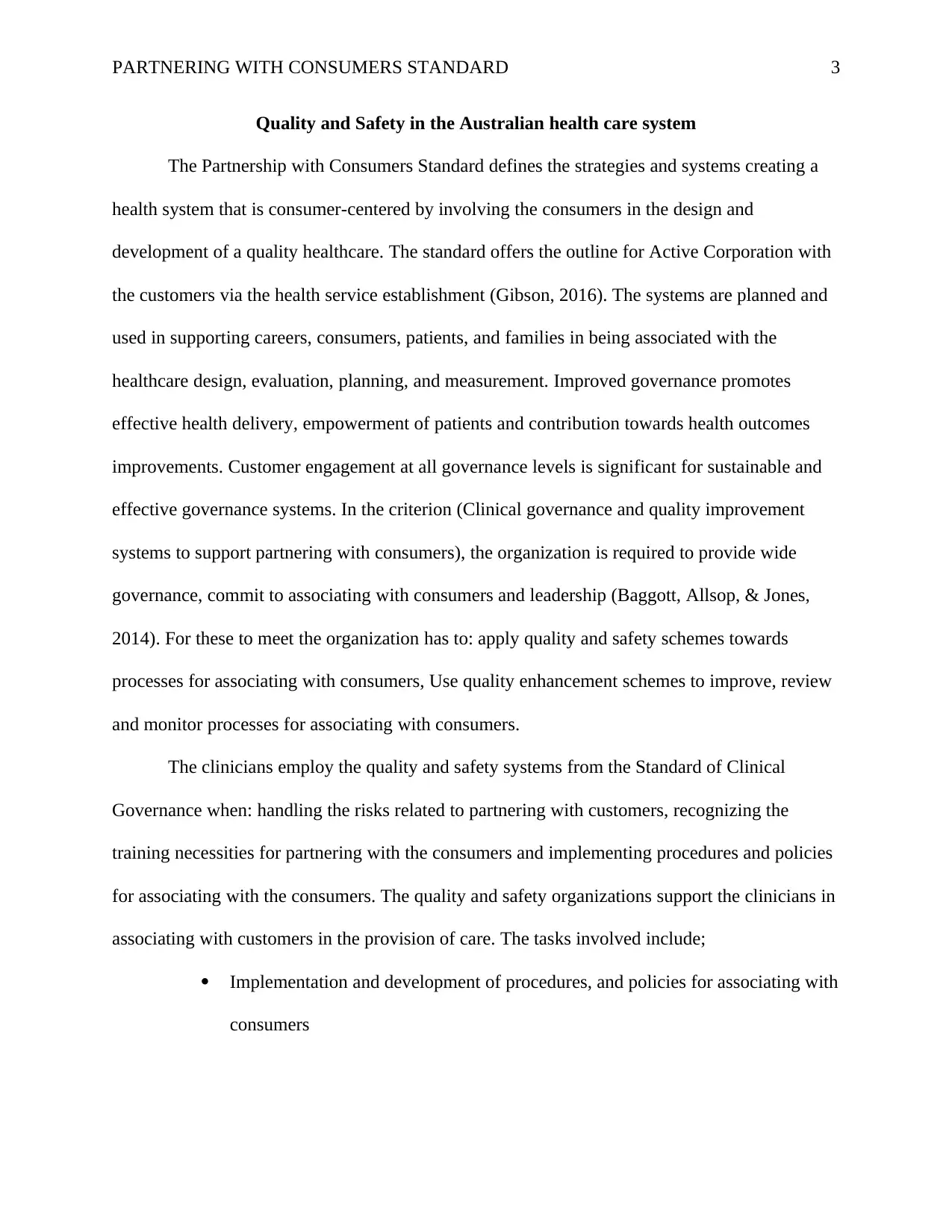
PARTNERING WITH CONSUMERS STANDARD 3
Quality and Safety in the Australian health care system
The Partnership with Consumers Standard defines the strategies and systems creating a
health system that is consumer-centered by involving the consumers in the design and
development of a quality healthcare. The standard offers the outline for Active Corporation with
the customers via the health service establishment (Gibson, 2016). The systems are planned and
used in supporting careers, consumers, patients, and families in being associated with the
healthcare design, evaluation, planning, and measurement. Improved governance promotes
effective health delivery, empowerment of patients and contribution towards health outcomes
improvements. Customer engagement at all governance levels is significant for sustainable and
effective governance systems. In the criterion (Clinical governance and quality improvement
systems to support partnering with consumers), the organization is required to provide wide
governance, commit to associating with consumers and leadership (Baggott, Allsop, & Jones,
2014). For these to meet the organization has to: apply quality and safety schemes towards
processes for associating with consumers, Use quality enhancement schemes to improve, review
and monitor processes for associating with consumers.
The clinicians employ the quality and safety systems from the Standard of Clinical
Governance when: handling the risks related to partnering with customers, recognizing the
training necessities for partnering with the consumers and implementing procedures and policies
for associating with the consumers. The quality and safety organizations support the clinicians in
associating with customers in the provision of care. The tasks involved include;
Implementation and development of procedures, and policies for associating with
consumers
Quality and Safety in the Australian health care system
The Partnership with Consumers Standard defines the strategies and systems creating a
health system that is consumer-centered by involving the consumers in the design and
development of a quality healthcare. The standard offers the outline for Active Corporation with
the customers via the health service establishment (Gibson, 2016). The systems are planned and
used in supporting careers, consumers, patients, and families in being associated with the
healthcare design, evaluation, planning, and measurement. Improved governance promotes
effective health delivery, empowerment of patients and contribution towards health outcomes
improvements. Customer engagement at all governance levels is significant for sustainable and
effective governance systems. In the criterion (Clinical governance and quality improvement
systems to support partnering with consumers), the organization is required to provide wide
governance, commit to associating with consumers and leadership (Baggott, Allsop, & Jones,
2014). For these to meet the organization has to: apply quality and safety schemes towards
processes for associating with consumers, Use quality enhancement schemes to improve, review
and monitor processes for associating with consumers.
The clinicians employ the quality and safety systems from the Standard of Clinical
Governance when: handling the risks related to partnering with customers, recognizing the
training necessities for partnering with the consumers and implementing procedures and policies
for associating with the consumers. The quality and safety organizations support the clinicians in
associating with customers in the provision of care. The tasks involved include;
Implementation and development of procedures, and policies for associating with
consumers
⊘ This is a preview!⊘
Do you want full access?
Subscribe today to unlock all pages.

Trusted by 1+ million students worldwide
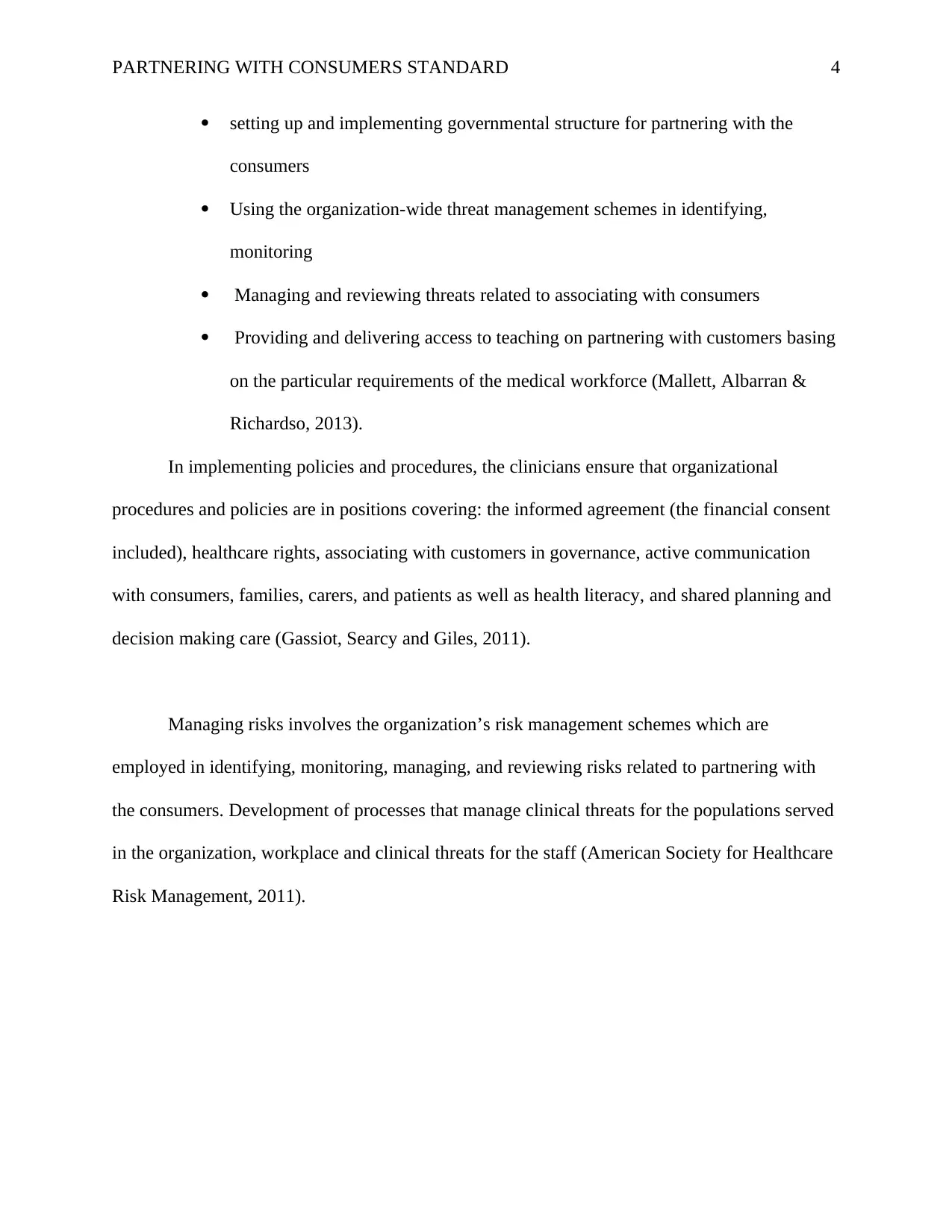
PARTNERING WITH CONSUMERS STANDARD 4
setting up and implementing governmental structure for partnering with the
consumers
Using the organization-wide threat management schemes in identifying,
monitoring
Managing and reviewing threats related to associating with consumers
Providing and delivering access to teaching on partnering with customers basing
on the particular requirements of the medical workforce (Mallett, Albarran &
Richardso, 2013).
In implementing policies and procedures, the clinicians ensure that organizational
procedures and policies are in positions covering: the informed agreement (the financial consent
included), healthcare rights, associating with customers in governance, active communication
with consumers, families, carers, and patients as well as health literacy, and shared planning and
decision making care (Gassiot, Searcy and Giles, 2011).
Managing risks involves the organization’s risk management schemes which are
employed in identifying, monitoring, managing, and reviewing risks related to partnering with
the consumers. Development of processes that manage clinical threats for the populations served
in the organization, workplace and clinical threats for the staff (American Society for Healthcare
Risk Management, 2011).
setting up and implementing governmental structure for partnering with the
consumers
Using the organization-wide threat management schemes in identifying,
monitoring
Managing and reviewing threats related to associating with consumers
Providing and delivering access to teaching on partnering with customers basing
on the particular requirements of the medical workforce (Mallett, Albarran &
Richardso, 2013).
In implementing policies and procedures, the clinicians ensure that organizational
procedures and policies are in positions covering: the informed agreement (the financial consent
included), healthcare rights, associating with customers in governance, active communication
with consumers, families, carers, and patients as well as health literacy, and shared planning and
decision making care (Gassiot, Searcy and Giles, 2011).
Managing risks involves the organization’s risk management schemes which are
employed in identifying, monitoring, managing, and reviewing risks related to partnering with
the consumers. Development of processes that manage clinical threats for the populations served
in the organization, workplace and clinical threats for the staff (American Society for Healthcare
Risk Management, 2011).
Paraphrase This Document
Need a fresh take? Get an instant paraphrase of this document with our AI Paraphraser
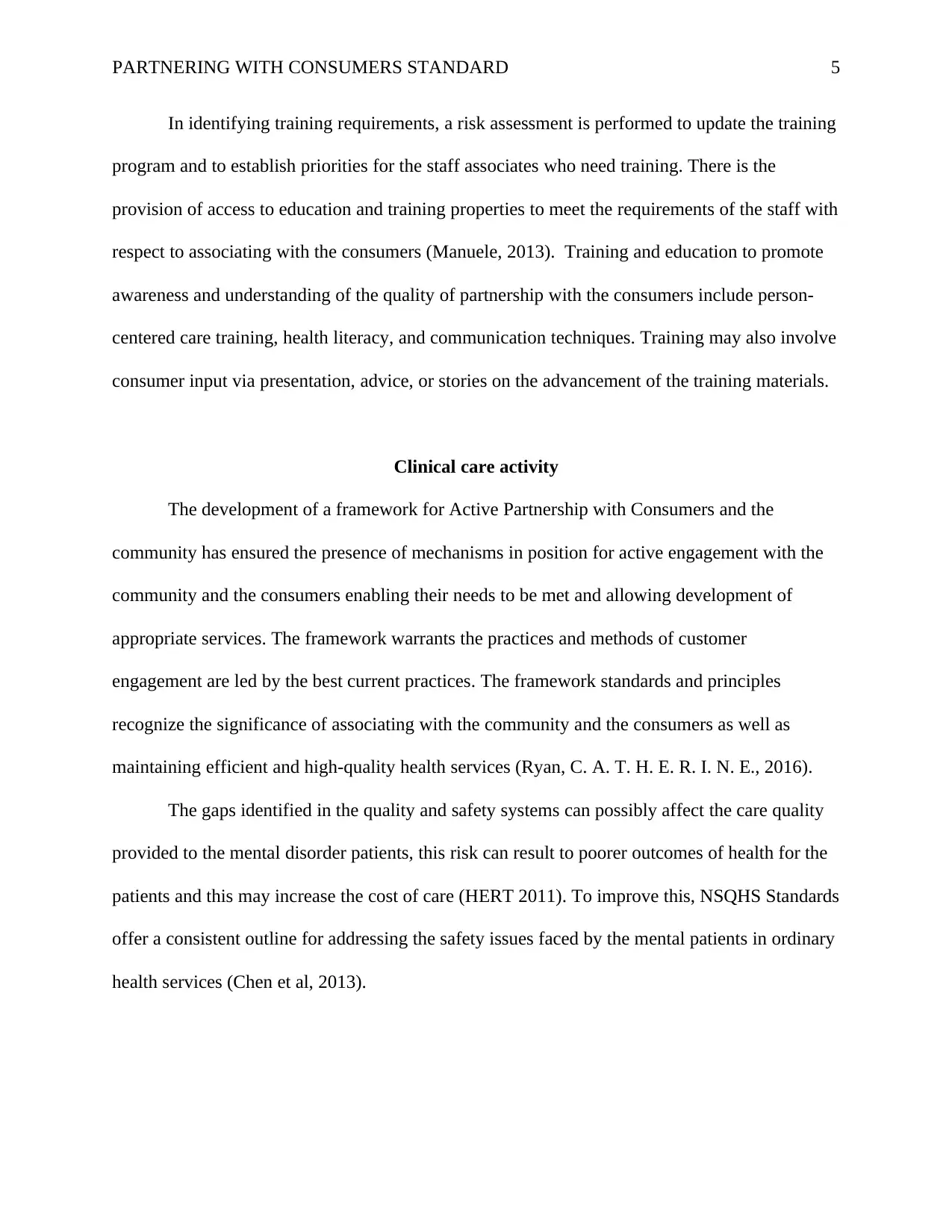
PARTNERING WITH CONSUMERS STANDARD 5
In identifying training requirements, a risk assessment is performed to update the training
program and to establish priorities for the staff associates who need training. There is the
provision of access to education and training properties to meet the requirements of the staff with
respect to associating with the consumers (Manuele, 2013). Training and education to promote
awareness and understanding of the quality of partnership with the consumers include person-
centered care training, health literacy, and communication techniques. Training may also involve
consumer input via presentation, advice, or stories on the advancement of the training materials.
Clinical care activity
The development of a framework for Active Partnership with Consumers and the
community has ensured the presence of mechanisms in position for active engagement with the
community and the consumers enabling their needs to be met and allowing development of
appropriate services. The framework warrants the practices and methods of customer
engagement are led by the best current practices. The framework standards and principles
recognize the significance of associating with the community and the consumers as well as
maintaining efficient and high-quality health services (Ryan, C. A. T. H. E. R. I. N. E., 2016).
The gaps identified in the quality and safety systems can possibly affect the care quality
provided to the mental disorder patients, this risk can result to poorer outcomes of health for the
patients and this may increase the cost of care (HERT 2011). To improve this, NSQHS Standards
offer a consistent outline for addressing the safety issues faced by the mental patients in ordinary
health services (Chen et al, 2013).
In identifying training requirements, a risk assessment is performed to update the training
program and to establish priorities for the staff associates who need training. There is the
provision of access to education and training properties to meet the requirements of the staff with
respect to associating with the consumers (Manuele, 2013). Training and education to promote
awareness and understanding of the quality of partnership with the consumers include person-
centered care training, health literacy, and communication techniques. Training may also involve
consumer input via presentation, advice, or stories on the advancement of the training materials.
Clinical care activity
The development of a framework for Active Partnership with Consumers and the
community has ensured the presence of mechanisms in position for active engagement with the
community and the consumers enabling their needs to be met and allowing development of
appropriate services. The framework warrants the practices and methods of customer
engagement are led by the best current practices. The framework standards and principles
recognize the significance of associating with the community and the consumers as well as
maintaining efficient and high-quality health services (Ryan, C. A. T. H. E. R. I. N. E., 2016).
The gaps identified in the quality and safety systems can possibly affect the care quality
provided to the mental disorder patients, this risk can result to poorer outcomes of health for the
patients and this may increase the cost of care (HERT 2011). To improve this, NSQHS Standards
offer a consistent outline for addressing the safety issues faced by the mental patients in ordinary
health services (Chen et al, 2013).
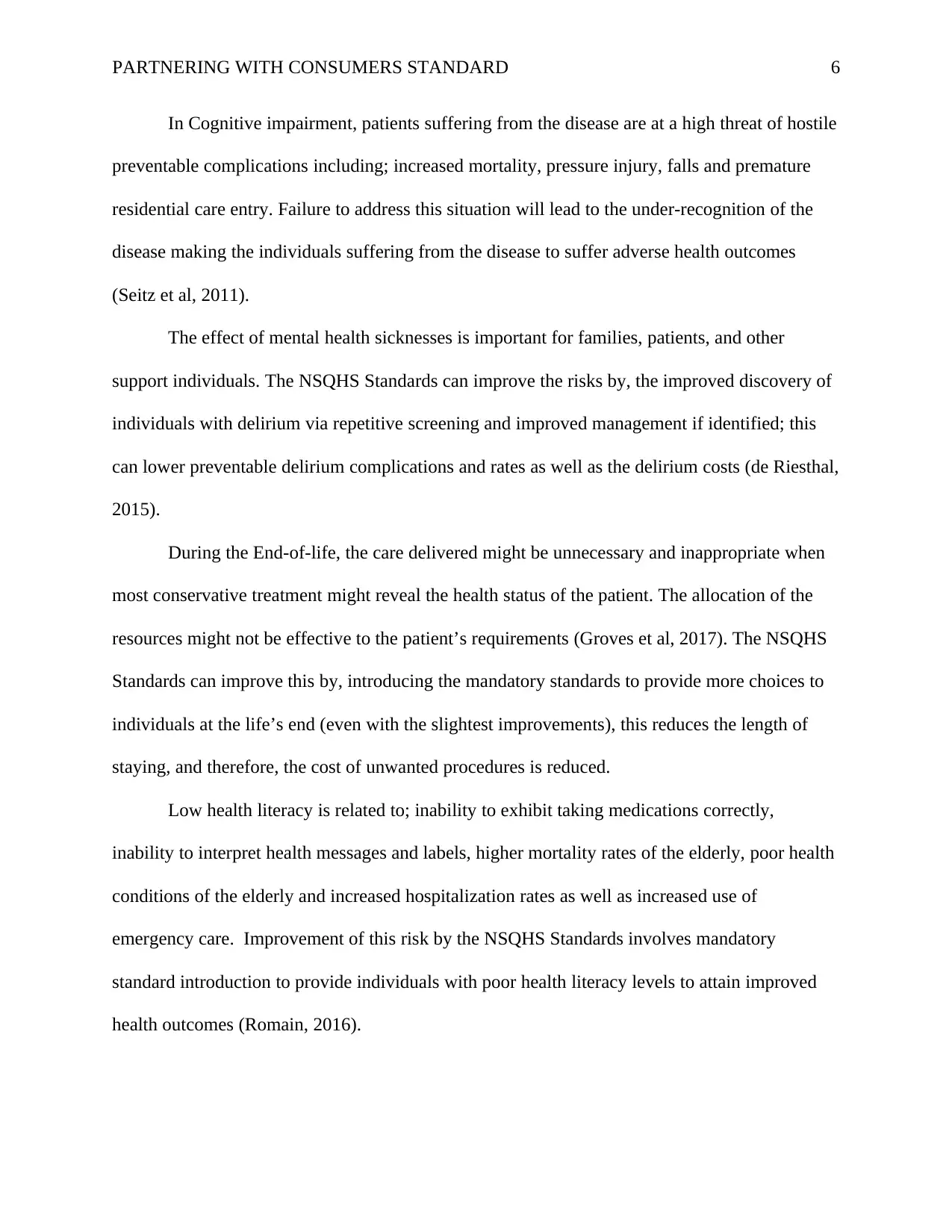
PARTNERING WITH CONSUMERS STANDARD 6
In Cognitive impairment, patients suffering from the disease are at a high threat of hostile
preventable complications including; increased mortality, pressure injury, falls and premature
residential care entry. Failure to address this situation will lead to the under-recognition of the
disease making the individuals suffering from the disease to suffer adverse health outcomes
(Seitz et al, 2011).
The effect of mental health sicknesses is important for families, patients, and other
support individuals. The NSQHS Standards can improve the risks by, the improved discovery of
individuals with delirium via repetitive screening and improved management if identified; this
can lower preventable delirium complications and rates as well as the delirium costs (de Riesthal,
2015).
During the End-of-life, the care delivered might be unnecessary and inappropriate when
most conservative treatment might reveal the health status of the patient. The allocation of the
resources might not be effective to the patient’s requirements (Groves et al, 2017). The NSQHS
Standards can improve this by, introducing the mandatory standards to provide more choices to
individuals at the life’s end (even with the slightest improvements), this reduces the length of
staying, and therefore, the cost of unwanted procedures is reduced.
Low health literacy is related to; inability to exhibit taking medications correctly,
inability to interpret health messages and labels, higher mortality rates of the elderly, poor health
conditions of the elderly and increased hospitalization rates as well as increased use of
emergency care. Improvement of this risk by the NSQHS Standards involves mandatory
standard introduction to provide individuals with poor health literacy levels to attain improved
health outcomes (Romain, 2016).
In Cognitive impairment, patients suffering from the disease are at a high threat of hostile
preventable complications including; increased mortality, pressure injury, falls and premature
residential care entry. Failure to address this situation will lead to the under-recognition of the
disease making the individuals suffering from the disease to suffer adverse health outcomes
(Seitz et al, 2011).
The effect of mental health sicknesses is important for families, patients, and other
support individuals. The NSQHS Standards can improve the risks by, the improved discovery of
individuals with delirium via repetitive screening and improved management if identified; this
can lower preventable delirium complications and rates as well as the delirium costs (de Riesthal,
2015).
During the End-of-life, the care delivered might be unnecessary and inappropriate when
most conservative treatment might reveal the health status of the patient. The allocation of the
resources might not be effective to the patient’s requirements (Groves et al, 2017). The NSQHS
Standards can improve this by, introducing the mandatory standards to provide more choices to
individuals at the life’s end (even with the slightest improvements), this reduces the length of
staying, and therefore, the cost of unwanted procedures is reduced.
Low health literacy is related to; inability to exhibit taking medications correctly,
inability to interpret health messages and labels, higher mortality rates of the elderly, poor health
conditions of the elderly and increased hospitalization rates as well as increased use of
emergency care. Improvement of this risk by the NSQHS Standards involves mandatory
standard introduction to provide individuals with poor health literacy levels to attain improved
health outcomes (Romain, 2016).
⊘ This is a preview!⊘
Do you want full access?
Subscribe today to unlock all pages.

Trusted by 1+ million students worldwide
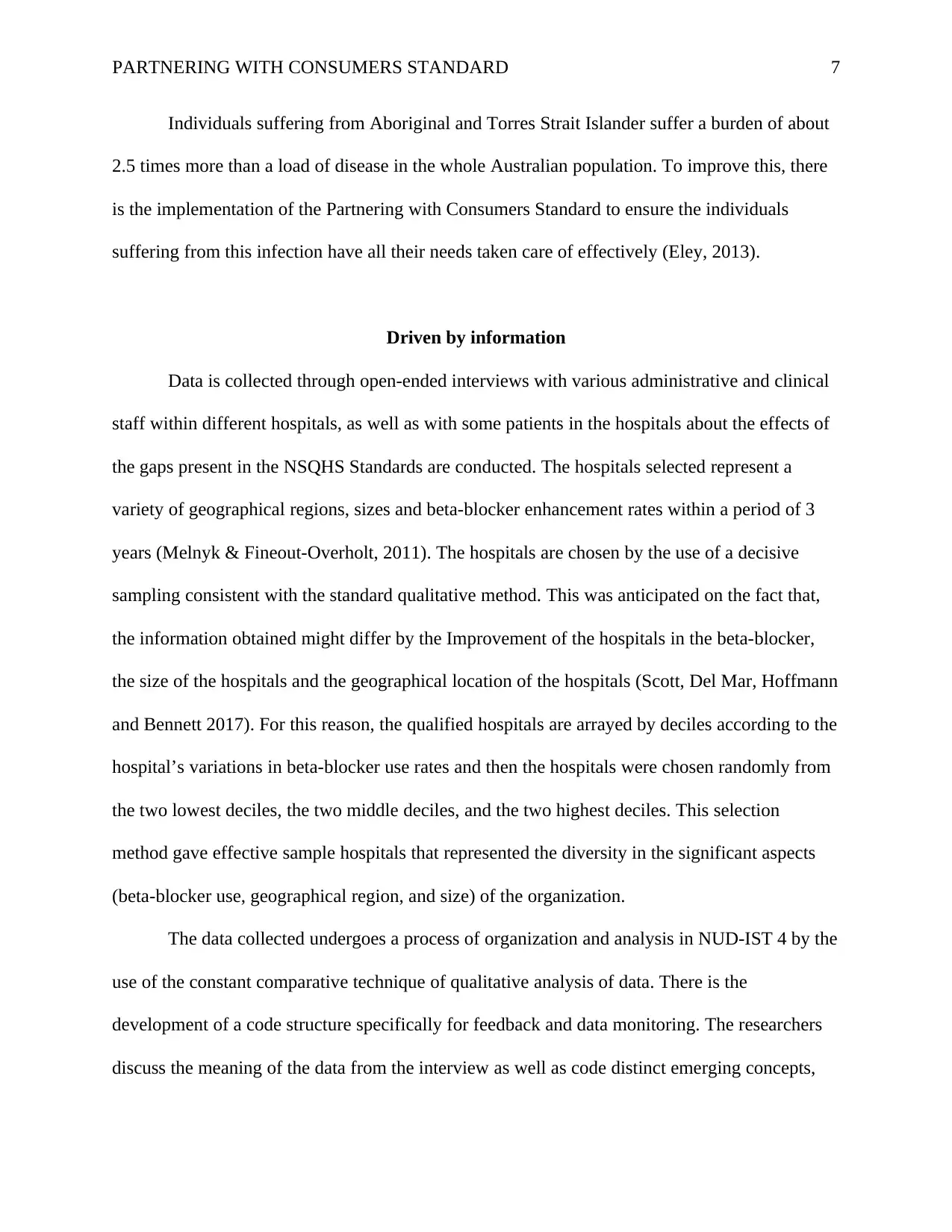
PARTNERING WITH CONSUMERS STANDARD 7
Individuals suffering from Aboriginal and Torres Strait Islander suffer a burden of about
2.5 times more than a load of disease in the whole Australian population. To improve this, there
is the implementation of the Partnering with Consumers Standard to ensure the individuals
suffering from this infection have all their needs taken care of effectively (Eley, 2013).
Driven by information
Data is collected through open-ended interviews with various administrative and clinical
staff within different hospitals, as well as with some patients in the hospitals about the effects of
the gaps present in the NSQHS Standards are conducted. The hospitals selected represent a
variety of geographical regions, sizes and beta-blocker enhancement rates within a period of 3
years (Melnyk & Fineout-Overholt, 2011). The hospitals are chosen by the use of a decisive
sampling consistent with the standard qualitative method. This was anticipated on the fact that,
the information obtained might differ by the Improvement of the hospitals in the beta-blocker,
the size of the hospitals and the geographical location of the hospitals (Scott, Del Mar, Hoffmann
and Bennett 2017). For this reason, the qualified hospitals are arrayed by deciles according to the
hospital’s variations in beta-blocker use rates and then the hospitals were chosen randomly from
the two lowest deciles, the two middle deciles, and the two highest deciles. This selection
method gave effective sample hospitals that represented the diversity in the significant aspects
(beta-blocker use, geographical region, and size) of the organization.
The data collected undergoes a process of organization and analysis in NUD-IST 4 by the
use of the constant comparative technique of qualitative analysis of data. There is the
development of a code structure specifically for feedback and data monitoring. The researchers
discuss the meaning of the data from the interview as well as code distinct emerging concepts,
Individuals suffering from Aboriginal and Torres Strait Islander suffer a burden of about
2.5 times more than a load of disease in the whole Australian population. To improve this, there
is the implementation of the Partnering with Consumers Standard to ensure the individuals
suffering from this infection have all their needs taken care of effectively (Eley, 2013).
Driven by information
Data is collected through open-ended interviews with various administrative and clinical
staff within different hospitals, as well as with some patients in the hospitals about the effects of
the gaps present in the NSQHS Standards are conducted. The hospitals selected represent a
variety of geographical regions, sizes and beta-blocker enhancement rates within a period of 3
years (Melnyk & Fineout-Overholt, 2011). The hospitals are chosen by the use of a decisive
sampling consistent with the standard qualitative method. This was anticipated on the fact that,
the information obtained might differ by the Improvement of the hospitals in the beta-blocker,
the size of the hospitals and the geographical location of the hospitals (Scott, Del Mar, Hoffmann
and Bennett 2017). For this reason, the qualified hospitals are arrayed by deciles according to the
hospital’s variations in beta-blocker use rates and then the hospitals were chosen randomly from
the two lowest deciles, the two middle deciles, and the two highest deciles. This selection
method gave effective sample hospitals that represented the diversity in the significant aspects
(beta-blocker use, geographical region, and size) of the organization.
The data collected undergoes a process of organization and analysis in NUD-IST 4 by the
use of the constant comparative technique of qualitative analysis of data. There is the
development of a code structure specifically for feedback and data monitoring. The researchers
discuss the meaning of the data from the interview as well as code distinct emerging concepts,
Paraphrase This Document
Need a fresh take? Get an instant paraphrase of this document with our AI Paraphraser
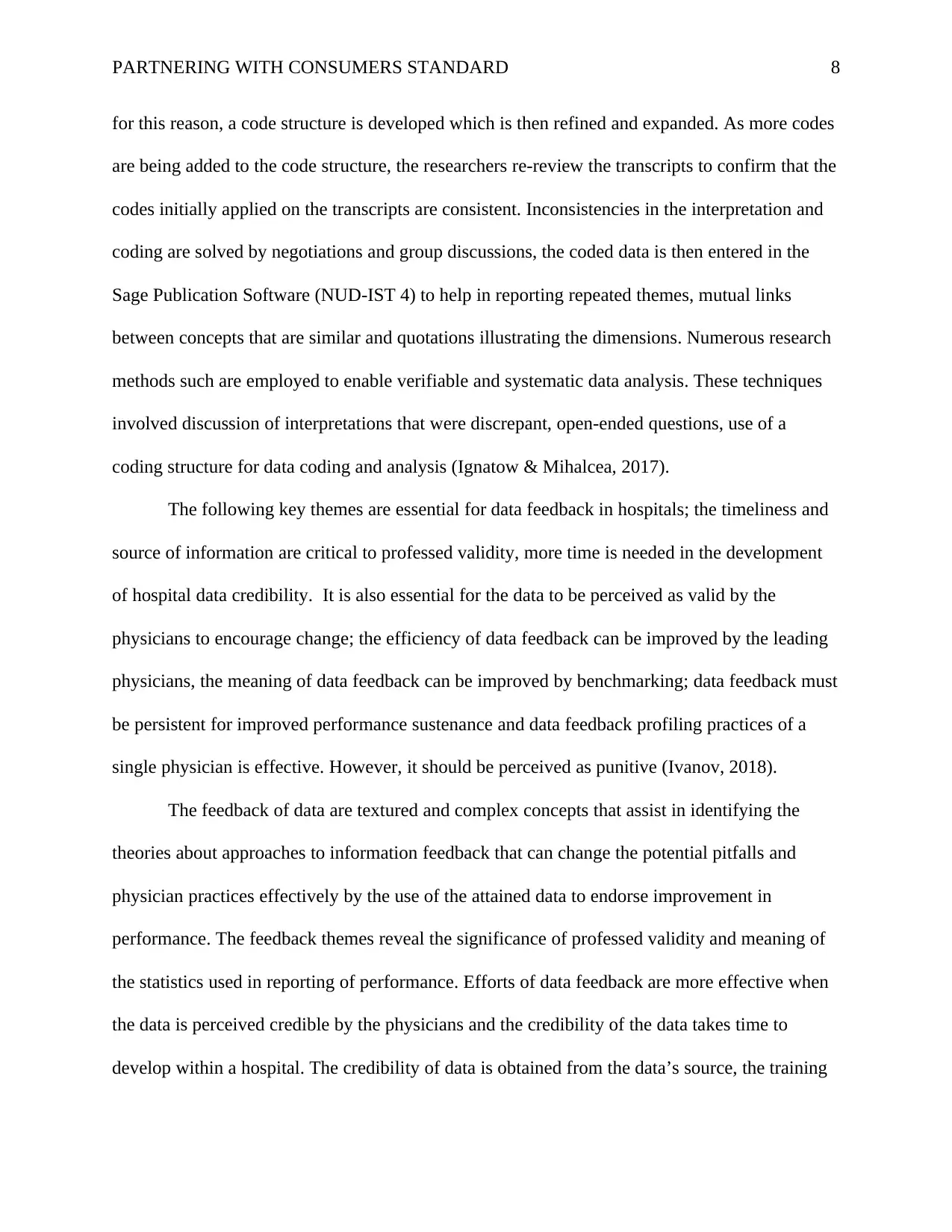
PARTNERING WITH CONSUMERS STANDARD 8
for this reason, a code structure is developed which is then refined and expanded. As more codes
are being added to the code structure, the researchers re-review the transcripts to confirm that the
codes initially applied on the transcripts are consistent. Inconsistencies in the interpretation and
coding are solved by negotiations and group discussions, the coded data is then entered in the
Sage Publication Software (NUD-IST 4) to help in reporting repeated themes, mutual links
between concepts that are similar and quotations illustrating the dimensions. Numerous research
methods such are employed to enable verifiable and systematic data analysis. These techniques
involved discussion of interpretations that were discrepant, open-ended questions, use of a
coding structure for data coding and analysis (Ignatow & Mihalcea, 2017).
The following key themes are essential for data feedback in hospitals; the timeliness and
source of information are critical to professed validity, more time is needed in the development
of hospital data credibility. It is also essential for the data to be perceived as valid by the
physicians to encourage change; the efficiency of data feedback can be improved by the leading
physicians, the meaning of data feedback can be improved by benchmarking; data feedback must
be persistent for improved performance sustenance and data feedback profiling practices of a
single physician is effective. However, it should be perceived as punitive (Ivanov, 2018).
The feedback of data are textured and complex concepts that assist in identifying the
theories about approaches to information feedback that can change the potential pitfalls and
physician practices effectively by the use of the attained data to endorse improvement in
performance. The feedback themes reveal the significance of professed validity and meaning of
the statistics used in reporting of performance. Efforts of data feedback are more effective when
the data is perceived credible by the physicians and the credibility of the data takes time to
develop within a hospital. The credibility of data is obtained from the data’s source, the training
for this reason, a code structure is developed which is then refined and expanded. As more codes
are being added to the code structure, the researchers re-review the transcripts to confirm that the
codes initially applied on the transcripts are consistent. Inconsistencies in the interpretation and
coding are solved by negotiations and group discussions, the coded data is then entered in the
Sage Publication Software (NUD-IST 4) to help in reporting repeated themes, mutual links
between concepts that are similar and quotations illustrating the dimensions. Numerous research
methods such are employed to enable verifiable and systematic data analysis. These techniques
involved discussion of interpretations that were discrepant, open-ended questions, use of a
coding structure for data coding and analysis (Ignatow & Mihalcea, 2017).
The following key themes are essential for data feedback in hospitals; the timeliness and
source of information are critical to professed validity, more time is needed in the development
of hospital data credibility. It is also essential for the data to be perceived as valid by the
physicians to encourage change; the efficiency of data feedback can be improved by the leading
physicians, the meaning of data feedback can be improved by benchmarking; data feedback must
be persistent for improved performance sustenance and data feedback profiling practices of a
single physician is effective. However, it should be perceived as punitive (Ivanov, 2018).
The feedback of data are textured and complex concepts that assist in identifying the
theories about approaches to information feedback that can change the potential pitfalls and
physician practices effectively by the use of the attained data to endorse improvement in
performance. The feedback themes reveal the significance of professed validity and meaning of
the statistics used in reporting of performance. Efforts of data feedback are more effective when
the data is perceived credible by the physicians and the credibility of the data takes time to
develop within a hospital. The credibility of data is obtained from the data’s source, the training
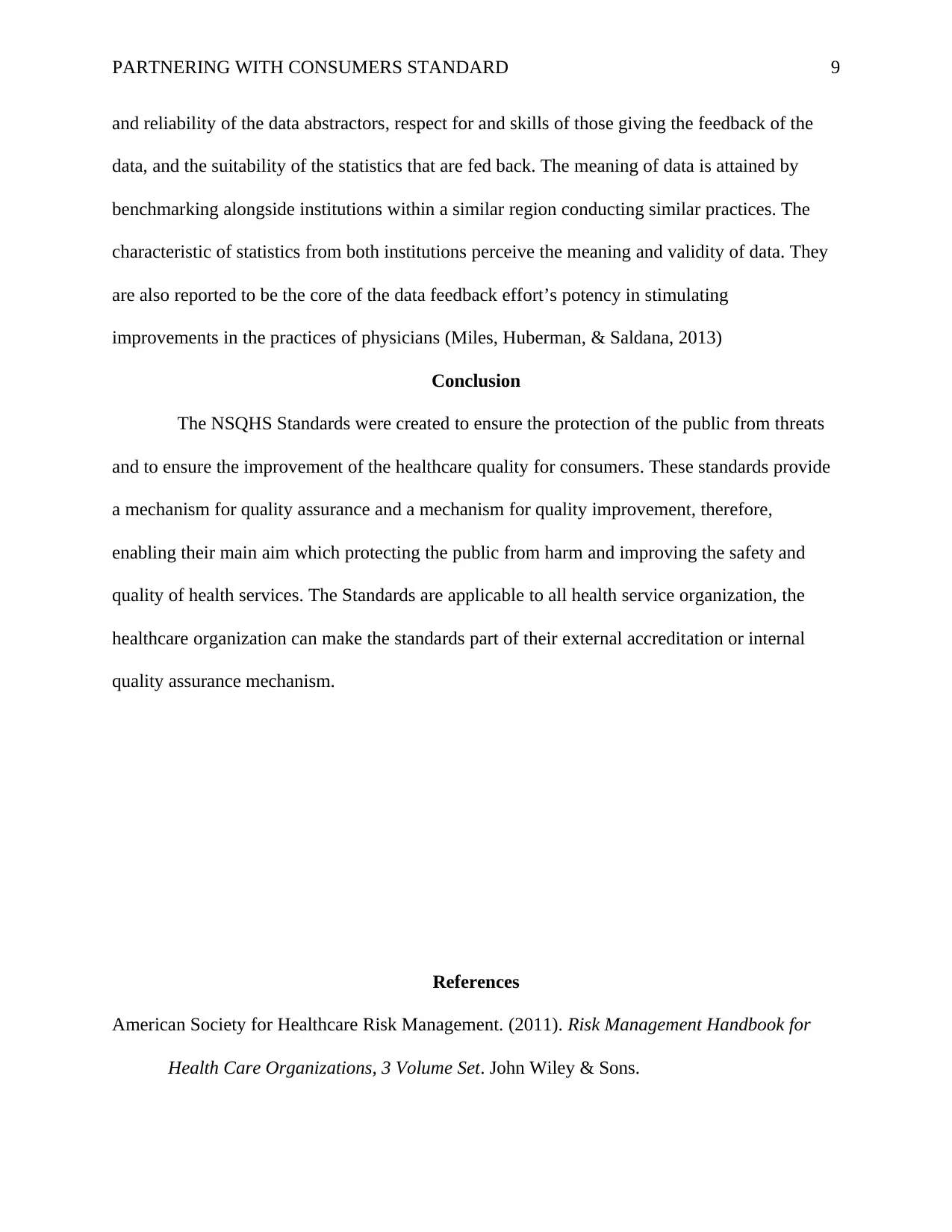
PARTNERING WITH CONSUMERS STANDARD 9
and reliability of the data abstractors, respect for and skills of those giving the feedback of the
data, and the suitability of the statistics that are fed back. The meaning of data is attained by
benchmarking alongside institutions within a similar region conducting similar practices. The
characteristic of statistics from both institutions perceive the meaning and validity of data. They
are also reported to be the core of the data feedback effort’s potency in stimulating
improvements in the practices of physicians (Miles, Huberman, & Saldana, 2013)
Conclusion
The NSQHS Standards were created to ensure the protection of the public from threats
and to ensure the improvement of the healthcare quality for consumers. These standards provide
a mechanism for quality assurance and a mechanism for quality improvement, therefore,
enabling their main aim which protecting the public from harm and improving the safety and
quality of health services. The Standards are applicable to all health service organization, the
healthcare organization can make the standards part of their external accreditation or internal
quality assurance mechanism.
References
American Society for Healthcare Risk Management. (2011). Risk Management Handbook for
Health Care Organizations, 3 Volume Set. John Wiley & Sons.
and reliability of the data abstractors, respect for and skills of those giving the feedback of the
data, and the suitability of the statistics that are fed back. The meaning of data is attained by
benchmarking alongside institutions within a similar region conducting similar practices. The
characteristic of statistics from both institutions perceive the meaning and validity of data. They
are also reported to be the core of the data feedback effort’s potency in stimulating
improvements in the practices of physicians (Miles, Huberman, & Saldana, 2013)
Conclusion
The NSQHS Standards were created to ensure the protection of the public from threats
and to ensure the improvement of the healthcare quality for consumers. These standards provide
a mechanism for quality assurance and a mechanism for quality improvement, therefore,
enabling their main aim which protecting the public from harm and improving the safety and
quality of health services. The Standards are applicable to all health service organization, the
healthcare organization can make the standards part of their external accreditation or internal
quality assurance mechanism.
References
American Society for Healthcare Risk Management. (2011). Risk Management Handbook for
Health Care Organizations, 3 Volume Set. John Wiley & Sons.
⊘ This is a preview!⊘
Do you want full access?
Subscribe today to unlock all pages.

Trusted by 1+ million students worldwide
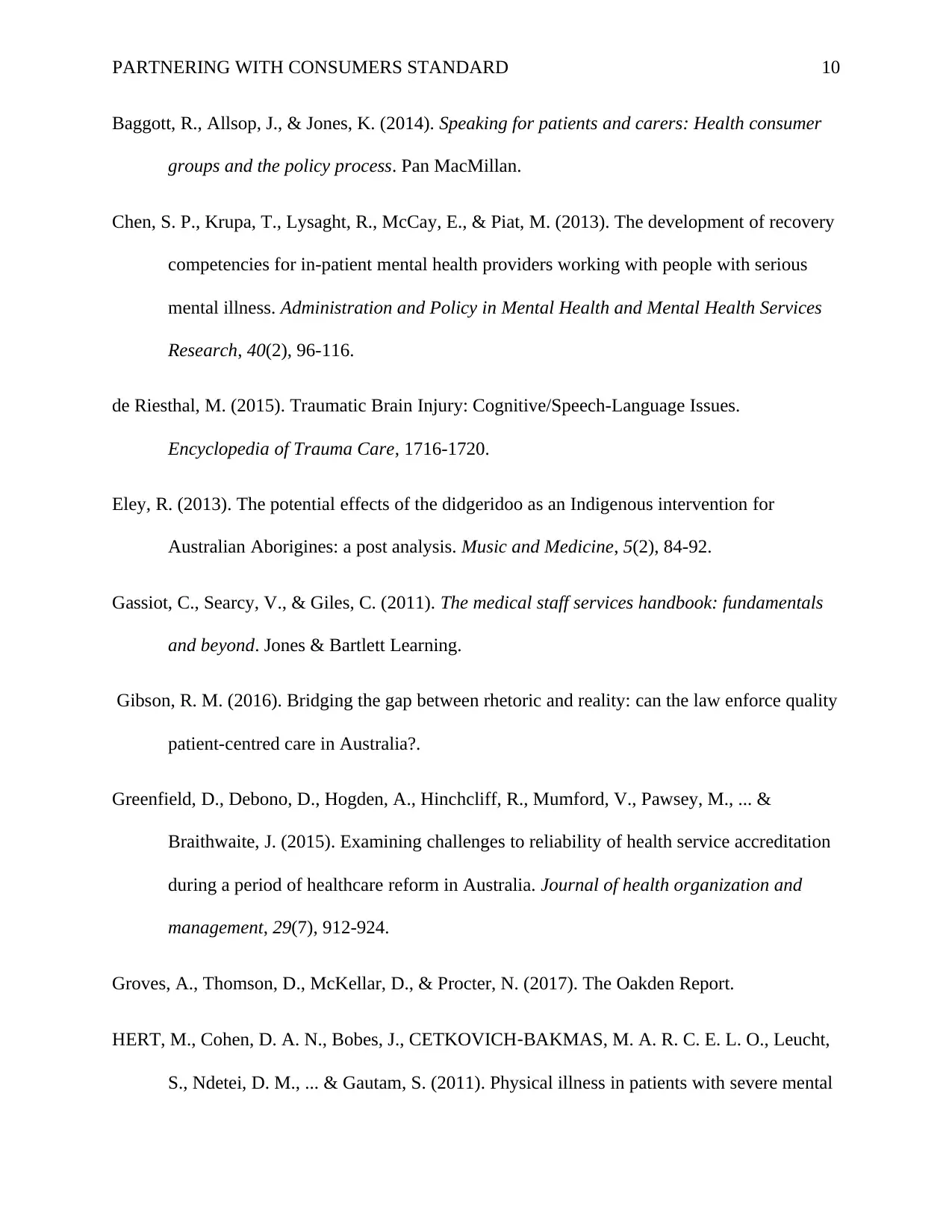
PARTNERING WITH CONSUMERS STANDARD 10
Baggott, R., Allsop, J., & Jones, K. (2014). Speaking for patients and carers: Health consumer
groups and the policy process. Pan MacMillan.
Chen, S. P., Krupa, T., Lysaght, R., McCay, E., & Piat, M. (2013). The development of recovery
competencies for in-patient mental health providers working with people with serious
mental illness. Administration and Policy in Mental Health and Mental Health Services
Research, 40(2), 96-116.
de Riesthal, M. (2015). Traumatic Brain Injury: Cognitive/Speech-Language Issues.
Encyclopedia of Trauma Care, 1716-1720.
Eley, R. (2013). The potential effects of the didgeridoo as an Indigenous intervention for
Australian Aborigines: a post analysis. Music and Medicine, 5(2), 84-92.
Gassiot, C., Searcy, V., & Giles, C. (2011). The medical staff services handbook: fundamentals
and beyond. Jones & Bartlett Learning.
Gibson, R. M. (2016). Bridging the gap between rhetoric and reality: can the law enforce quality
patient-centred care in Australia?.
Greenfield, D., Debono, D., Hogden, A., Hinchcliff, R., Mumford, V., Pawsey, M., ... &
Braithwaite, J. (2015). Examining challenges to reliability of health service accreditation
during a period of healthcare reform in Australia. Journal of health organization and
management, 29(7), 912-924.
Groves, A., Thomson, D., McKellar, D., & Procter, N. (2017). The Oakden Report.
HERT, M., Cohen, D. A. N., Bobes, J., CETKOVICH‐BAKMAS, M. A. R. C. E. L. O., Leucht,
S., Ndetei, D. M., ... & Gautam, S. (2011). Physical illness in patients with severe mental
Baggott, R., Allsop, J., & Jones, K. (2014). Speaking for patients and carers: Health consumer
groups and the policy process. Pan MacMillan.
Chen, S. P., Krupa, T., Lysaght, R., McCay, E., & Piat, M. (2013). The development of recovery
competencies for in-patient mental health providers working with people with serious
mental illness. Administration and Policy in Mental Health and Mental Health Services
Research, 40(2), 96-116.
de Riesthal, M. (2015). Traumatic Brain Injury: Cognitive/Speech-Language Issues.
Encyclopedia of Trauma Care, 1716-1720.
Eley, R. (2013). The potential effects of the didgeridoo as an Indigenous intervention for
Australian Aborigines: a post analysis. Music and Medicine, 5(2), 84-92.
Gassiot, C., Searcy, V., & Giles, C. (2011). The medical staff services handbook: fundamentals
and beyond. Jones & Bartlett Learning.
Gibson, R. M. (2016). Bridging the gap between rhetoric and reality: can the law enforce quality
patient-centred care in Australia?.
Greenfield, D., Debono, D., Hogden, A., Hinchcliff, R., Mumford, V., Pawsey, M., ... &
Braithwaite, J. (2015). Examining challenges to reliability of health service accreditation
during a period of healthcare reform in Australia. Journal of health organization and
management, 29(7), 912-924.
Groves, A., Thomson, D., McKellar, D., & Procter, N. (2017). The Oakden Report.
HERT, M., Cohen, D. A. N., Bobes, J., CETKOVICH‐BAKMAS, M. A. R. C. E. L. O., Leucht,
S., Ndetei, D. M., ... & Gautam, S. (2011). Physical illness in patients with severe mental
Paraphrase This Document
Need a fresh take? Get an instant paraphrase of this document with our AI Paraphraser
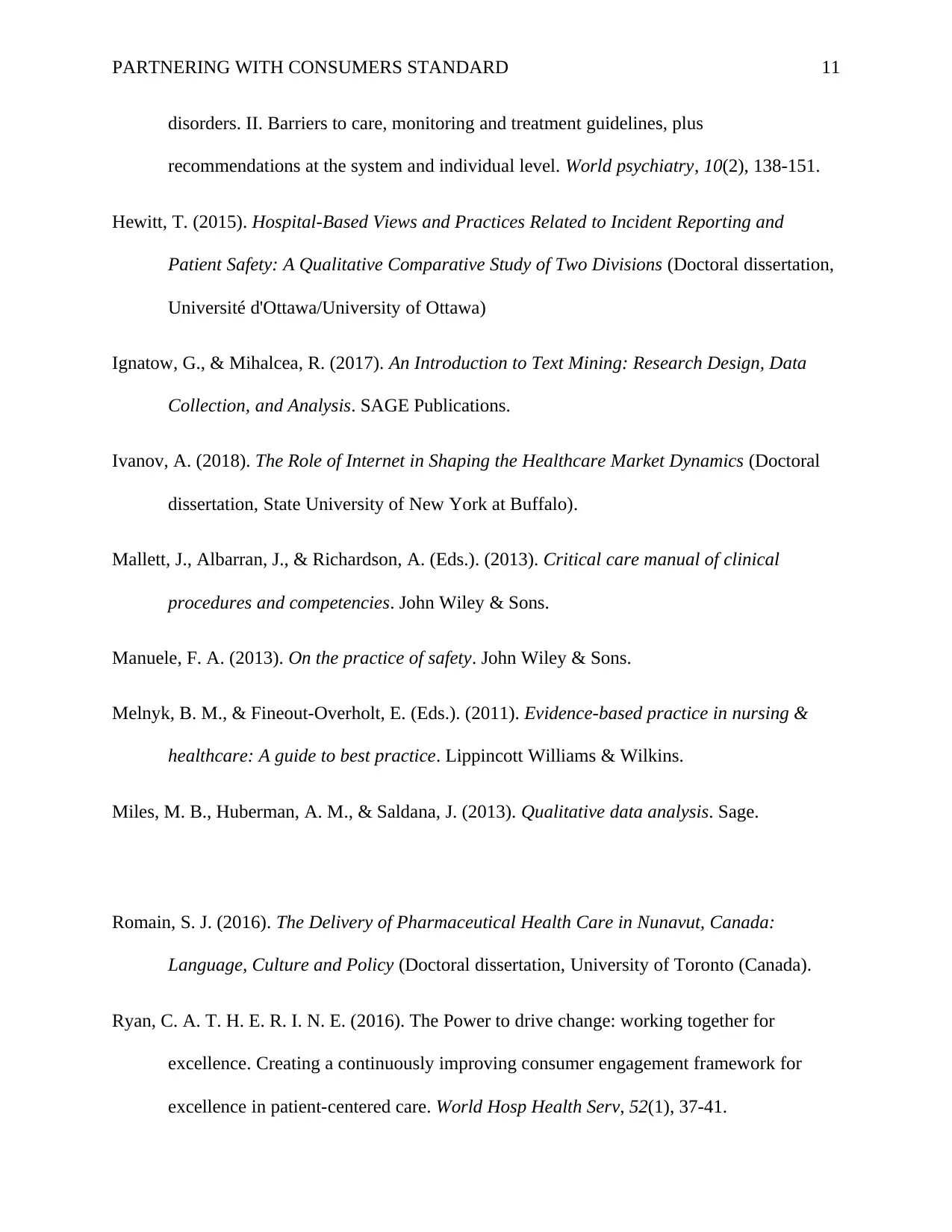
PARTNERING WITH CONSUMERS STANDARD 11
disorders. II. Barriers to care, monitoring and treatment guidelines, plus
recommendations at the system and individual level. World psychiatry, 10(2), 138-151.
Hewitt, T. (2015). Hospital-Based Views and Practices Related to Incident Reporting and
Patient Safety: A Qualitative Comparative Study of Two Divisions (Doctoral dissertation,
Université d'Ottawa/University of Ottawa)
Ignatow, G., & Mihalcea, R. (2017). An Introduction to Text Mining: Research Design, Data
Collection, and Analysis. SAGE Publications.
Ivanov, A. (2018). The Role of Internet in Shaping the Healthcare Market Dynamics (Doctoral
dissertation, State University of New York at Buffalo).
Mallett, J., Albarran, J., & Richardson, A. (Eds.). (2013). Critical care manual of clinical
procedures and competencies. John Wiley & Sons.
Manuele, F. A. (2013). On the practice of safety. John Wiley & Sons.
Melnyk, B. M., & Fineout-Overholt, E. (Eds.). (2011). Evidence-based practice in nursing &
healthcare: A guide to best practice. Lippincott Williams & Wilkins.
Miles, M. B., Huberman, A. M., & Saldana, J. (2013). Qualitative data analysis. Sage.
Romain, S. J. (2016). The Delivery of Pharmaceutical Health Care in Nunavut, Canada:
Language, Culture and Policy (Doctoral dissertation, University of Toronto (Canada).
Ryan, C. A. T. H. E. R. I. N. E. (2016). The Power to drive change: working together for
excellence. Creating a continuously improving consumer engagement framework for
excellence in patient-centered care. World Hosp Health Serv, 52(1), 37-41.
disorders. II. Barriers to care, monitoring and treatment guidelines, plus
recommendations at the system and individual level. World psychiatry, 10(2), 138-151.
Hewitt, T. (2015). Hospital-Based Views and Practices Related to Incident Reporting and
Patient Safety: A Qualitative Comparative Study of Two Divisions (Doctoral dissertation,
Université d'Ottawa/University of Ottawa)
Ignatow, G., & Mihalcea, R. (2017). An Introduction to Text Mining: Research Design, Data
Collection, and Analysis. SAGE Publications.
Ivanov, A. (2018). The Role of Internet in Shaping the Healthcare Market Dynamics (Doctoral
dissertation, State University of New York at Buffalo).
Mallett, J., Albarran, J., & Richardson, A. (Eds.). (2013). Critical care manual of clinical
procedures and competencies. John Wiley & Sons.
Manuele, F. A. (2013). On the practice of safety. John Wiley & Sons.
Melnyk, B. M., & Fineout-Overholt, E. (Eds.). (2011). Evidence-based practice in nursing &
healthcare: A guide to best practice. Lippincott Williams & Wilkins.
Miles, M. B., Huberman, A. M., & Saldana, J. (2013). Qualitative data analysis. Sage.
Romain, S. J. (2016). The Delivery of Pharmaceutical Health Care in Nunavut, Canada:
Language, Culture and Policy (Doctoral dissertation, University of Toronto (Canada).
Ryan, C. A. T. H. E. R. I. N. E. (2016). The Power to drive change: working together for
excellence. Creating a continuously improving consumer engagement framework for
excellence in patient-centered care. World Hosp Health Serv, 52(1), 37-41.
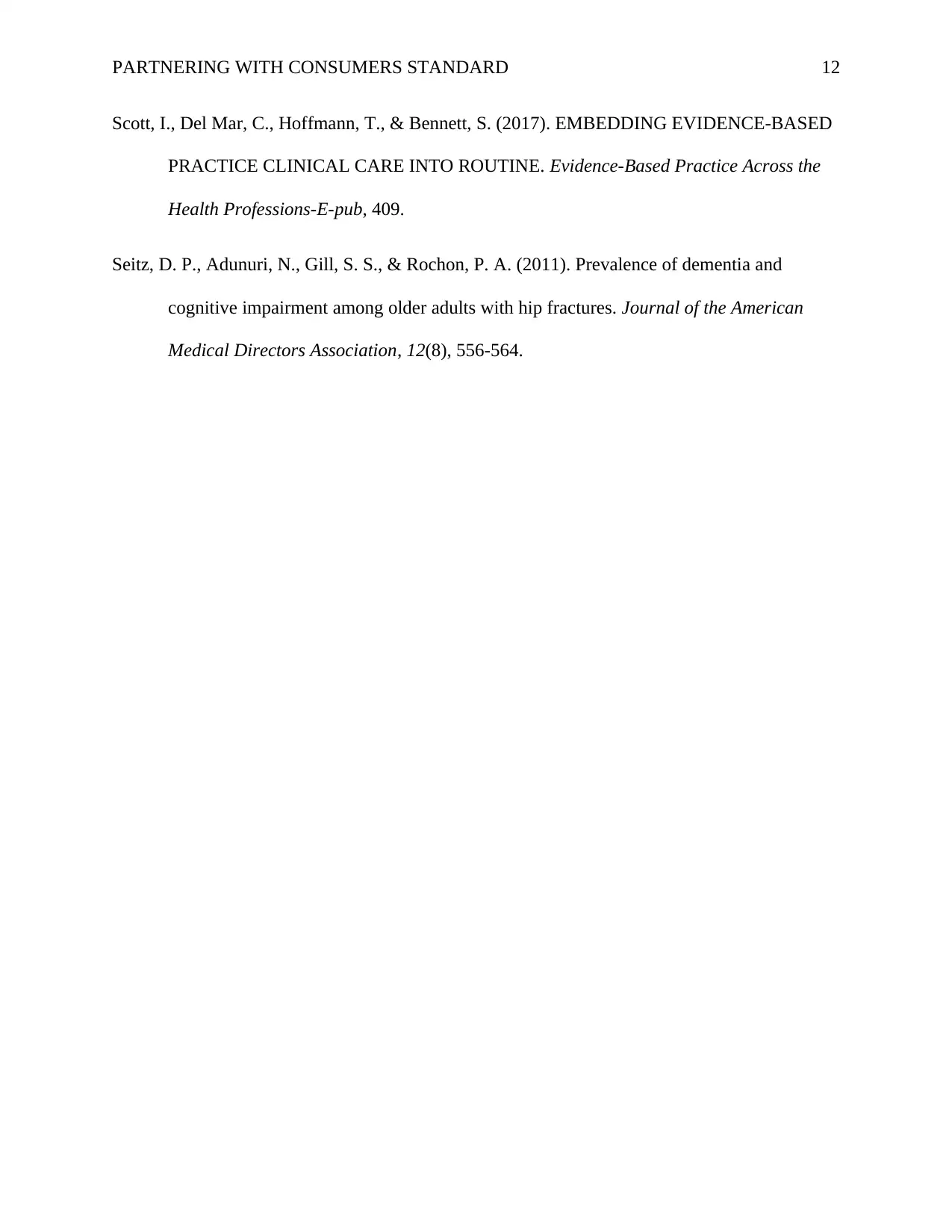
PARTNERING WITH CONSUMERS STANDARD 12
Scott, I., Del Mar, C., Hoffmann, T., & Bennett, S. (2017). EMBEDDING EVIDENCE-BASED
PRACTICE CLINICAL CARE INTO ROUTINE. Evidence-Based Practice Across the
Health Professions-E-pub, 409.
Seitz, D. P., Adunuri, N., Gill, S. S., & Rochon, P. A. (2011). Prevalence of dementia and
cognitive impairment among older adults with hip fractures. Journal of the American
Medical Directors Association, 12(8), 556-564.
Scott, I., Del Mar, C., Hoffmann, T., & Bennett, S. (2017). EMBEDDING EVIDENCE-BASED
PRACTICE CLINICAL CARE INTO ROUTINE. Evidence-Based Practice Across the
Health Professions-E-pub, 409.
Seitz, D. P., Adunuri, N., Gill, S. S., & Rochon, P. A. (2011). Prevalence of dementia and
cognitive impairment among older adults with hip fractures. Journal of the American
Medical Directors Association, 12(8), 556-564.
⊘ This is a preview!⊘
Do you want full access?
Subscribe today to unlock all pages.

Trusted by 1+ million students worldwide
1 out of 12
Related Documents
Your All-in-One AI-Powered Toolkit for Academic Success.
+13062052269
info@desklib.com
Available 24*7 on WhatsApp / Email
![[object Object]](/_next/static/media/star-bottom.7253800d.svg)
Unlock your academic potential
Copyright © 2020–2025 A2Z Services. All Rights Reserved. Developed and managed by ZUCOL.





